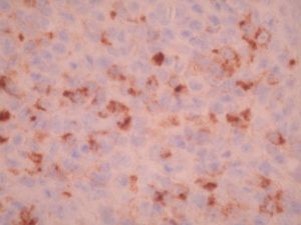CXCL13 by IHC
CXCL13 by IHC-12376 - Technical only, 12379 - Technical & interpretation
CXCL13 by IHC
12376 - Technical only, 12379 - Technical & interpretation
LAB12376
LAB12379
LAB12379
All IHC stains will include a positive control tissue
- Useful in identifying neoplastic cells in angioimmunoblastic T-cell lymphoma (AITL); 100% staining, in 29 of 29 AITL cases 1; 89% staining, in 31 of 35 cases 2
- CXCL13 staining generally shows clusters of positive cells in the paracortex in cases of AITL
- CXCL13 expression in AITL supports is derivation from follicular T helper cells
- CXCL13 can also identify a subset of peripheral T-cell lymphomas (in particular, those that show borderline features with AITL; 6 of 20 cases/30% 1)
- CXCL13 expression is not seen in anaplastic large cell lymphomas
- CXCL13 staining is helpful in identifying AITL of the skin 3, with positive staining in 80% of cases, compared to none in controls. In positive cases, less than 10% of lymphocytes stain, as scattered single cells or small clusters; a positive cell usually has 1 or 2 small paranuclear dots (these cases are often CD10 negative, in contrast to what is seen in non-skin related sites of involvement)
- In normal and reactive lymph nodes, CXCL13 positive cells are generally seen scattered in the germinal centers, including in follicular dendritic cells, histiocytes and rare small lymphocytes, with rare single cells also seen in the paracortex
Tissue
Submit a formalin-fixed, paraffin-embedded tissue
Formalin-fixed, paraffin-embedded (FFPE) tissue block
FFPE tissue section mounted on a charged, unstained slide
Ambient (preferred)
- Unlabeled/mislabeled block
- Insufficient tissue
- Slides broken beyond repair
AHL - Immunohistochemistry
Mo - Fr
1 - 2 days
Immunohistochemical staining and microscopic examination
If requested, an interpretive report will be provided
Specifications
- CXCL13 is a CXC chemokine, which is expressed in secondary lymphoid organs (it is involved in lymphoid organogenesis and B-cell migration into germinal centers)
- CXCL13 acts as a chemoattractant by interacting with CXCR5 on B cells and a subpopulation of T helper memory cells
Staining pattern
- Cytoplasmic, sometimes with a dot-like pattern in the Golgi area
References
- Dupuis J et al: Expression of CXCL13 by neoplastic cells in angioimmunoblastic T-cell lymphoma (AITL). Am J Surg Pathol 2006; 30: 490-494.
- Grogg KL et al: Expression of CXCL13, a chemokine highly upregulated in germinal center T-helper cells, distinguishes angioimmunoblastic T-cell lymphoma from peripheral T-cell lymphoma, unspecified. Mod Pathol 2006, 19, 1101-1107.
- Ortonne N et al: Characterization of CXCL13 Neoplastic T cells in cutaneous lesions of angioimmunoblastic T-cell lymphoma (AITL); Am J Surg Pathol 2007; 31: 1068-1076
88342 - 1st stain
88341 - each additional stain
88341 - each additional stain
06/16/2017
10/18/2018
01/12/2024
